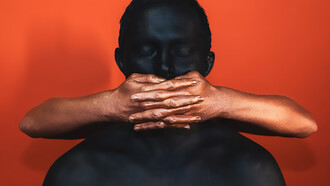Welcome to the land of ghosts
and please remove your shoes at the door1.
So reads the ambivalent greeting in Simon Scott’s Postcard from Tokyo, one of the highlights of volume five of Tokyo Poetry Journal. ToPoJo offers what its editors describe as “a hallucinatory universe… a primordial alphabet soup” created by “bebop bards”, “sa(l)vage alchemists” and “fractured experimentalists” 2. Lyrical descriptions of “sliding doors open[ing] / on pachinko din” and 3 “smiles fall[ing] like dead petals / on the subway floor” 4 feature alongside English translations of Japanese poems such as Miki Yuuri’s Anal Fuck Suburban and Yamada Ryota’s Contemporary Poetry Wikipedia Parade. More than a literary journal, ToPoJo presents itself as “a space of resistance” to “an historic national refusal to procreate, an economy that generates disappointment… and a government that turns to superflat pop arts for international image-doctoring while it tries to eat the humanities for breakfast” 5. I spoke to editors, poets and translators Jeffrey Johnson, Taylor Mignon and Jordan A. Y. Smith about their provocative project.
As they describe, each issue of ToPoJo is an “alphabet confetti” of ideas and impressions, rhymes and ruminations. Jordan insists: “We are part beat, we are part punk, we are part classic and we are part modernist, we are part surrealist, we are part slam”. The journal is also, as Jordan points out, “the place for young Japanese poets to get it out in English”. Previously, only the most senior and prestigious Japanese poets stood a chance at English translation. Now, “a whole generation of poets in their twenties, thirties, forties that are doing just amazingly cool things” have an international platform. By bringing the rest of the world up to date, ToPoJo seeks to challenge prevailing prejudices. Taylor protests: “All the time even until now Japanese gets this rap of being derivational”, pointing to international neglect of the modernist poet Torii Shōzō. and bands such as the Boredoms and Melt-Banana. In addition, the journal seeks to foster a more holistic recognition of Japan’s global connections: one issue explores the relationship between Spanish and Japanese poets; another volume traces connections between Japanese and Arabic poetry. Jordan affirms: “Showing Japan in all its transnationality and showing these currents of culture and influence and friendship are essential to understanding Japan.”
ToPoJo is also famous for its raucous launch parties. The celebration for volume six, for instance, ended with a twenty-minute musical and dance performance in which Butoh practitioners Kudo Taketeru and Barabbas Okuyama were “literally ripping the stage pallets apart and chucking them around the room.” Jordan recalls: “It looked like an earthquake hit.” He adds: “I think that really stuns a lot of people when we say it’s like the wildest poetry party you can imagine. They’re like ‘well I don't really imagine poetry parties being very wild… how many cups of tea did you have?’ But they are wild and they go late and they rock.” Through performance, the poets seek to reignite creative fire. Taylor explains: “If you are going to write a poem, there’s a reason why you wrote it there’s a spark there… If you are going to present it to people it does not make sense to me why you would want to do that in a very dry manner… why bother?” He emphasizes the symbiosis between publication and live event. “What we like to do is put a spotlight on the contributors to the issue itself. And then, if they are in town we like to invite them onstage and then there’s the option of music as well. So, it really goes hand in hand.”
Jeffrey recalls that ToPoJo began after he and the poet and Professor Barbara Summerhawk realized that “there wasn't an in-print form in this huge metropolitan city of Tokyo—in English anyway—that was a forum for poetry.” They brought on board Taylor as editor-in-chief for volume one, and Jordan as Japanese language editor for volume two. Taylor describes how ToPoJo responds to an explosion of international literary and musical performance: “After almost thirty years in Japan, this was a high point of creative improvisation between musicians and poets. We wanted to show this excitement on paper”. Indeed, so important is the connection between music and poetry in ToPoJo’s activities that Jeffrey not only made music the theme of volume three but even innovated by printing QR codes below poems that link to related music. In keeping with this creative use of technology, the team promotes their activities on the internet, putting two sample poems from each issue online and promoting their launch parties via social media. They describe the internet pragmatically as “where people live nowadays”, and Taylor’s line “[n]othing replaces the crispness of papyrus” pokes fun at fears about digitization. New projects include volume nine, edited by Barbara, which focuses on LGBQT issues and ToPoJo Excursions, a book series.
In their view, the main merits of the contemporary Japanese poetry scene are its diversity and openness. Jordan describes: “There are rappers, there are angsty twenty-somethings, there are also people who are highly abstract, there are people that would incorporate sign language into their poetry, there are imagists and surrealists—all kinds of really cool things.” The editors reject the view that poetry is an elite art-form. Jordan enumerates: “A slogan in a commercial… Or a bad ass Arnold Schwarzenegger line that just rings in your head twenty years after you hear it in some stupid action movie. All of that stuff is poetry.” Most importantly, poetry offers an alternative to conformity. Jordan clarifies: “The Japanese poetry scene… is definitely where people who are misfits in different ways can get together and express. And when I say ‘misfit’ too—it can be a person who is just an internal or psychological misfit—like someone who can masquerade during the day and sort of ‘pass’ in their company. But then they come and let it hang out in the poetry world. And it's a place where affection is expressed differently. And friendship is a little warmer.”
The editors emphasize that Japan is a country of contrasts and contradictions. Jordan notes: “Some people are totally in the salaryman world and they are drowned in getting smashed by the machine. And other people are like rebel poets who have been homeless for so long they can only sleep if they are touching the ground.” In turn, Jeffrey stresses both the variety of different cultures that exist within the country and its increasing internationalism: “One thing is realizing how diverse the Japanese really are, and another thing is the mix that Tokyo has become… there was a time when I looked down the train car and I would be the only non-Japanese in the train car. Now I look down the same train car and I can’t imagine who is Japanese.” Nonetheless, they rail against the current Liberal Democrat Party of Japan, in particular the Ministry of Education’s neglect of the humanities. Jordan protests: “The Japanese government with its left hand is selling all the creative output of the country, while they are also destroying humanities and the arts too. Those things go hand in hand.” At the same time, he emphasizes poetry’s resilience: “You don't have to have institutional and economic support to be a creative person—and I think that’s also why poetry flourishes in any economic conditions.” ToPoJo’s exuberant mixture of beat and butoh, slam and surrealism, provides a refuge for imagination and iconoclasm in deadening times. In her ToPoJo poem Breakfast in Neo-Tokyo Holly Lanasolyluna writes:
Guitars were outlawed years ago
So were bars, newspapers, TV shows
Still a rebel musician strums away by the station
A remnant of what was our civilization.6
1 Simon Scott “Postcard from Tokyo” Taylor Mignon (ed.) Tokyo Poetry Journal Vol. 5: Japan and the Beats, pp. 118-120.
2 Todd Silverstein and Jordan A. Y. Smith, “Introduction”, Jordan A. Y. Smith, Tokyo Poetry Journal: Volume Eight, Tokyo: Printed Matter Press, 2019.
3 Phillip Rowland, “Scattered Tokyo Poems”, Mignon (ed.) Tokyo Poetry Journal Vol. 5, pp. 90-1.
4 Ira Cohen “Blue Train, for John Solt”, ibid., p. 95.
5 Jordan A. Y. Smith, “Heisei Generations: Poetic Function and Anti-Function in an Era of Abdication”, Jordan A. Y. Smith (ed.) Tokyo Poetry Journal Volume Four: Heisei Generations, Tokyo: Printed Matter Press, 2017, pp. 5-13, p. 7 and p. 5.
6Mignon (ed.) Tokyo Poetry Journal Vol. 5, p. 122.















